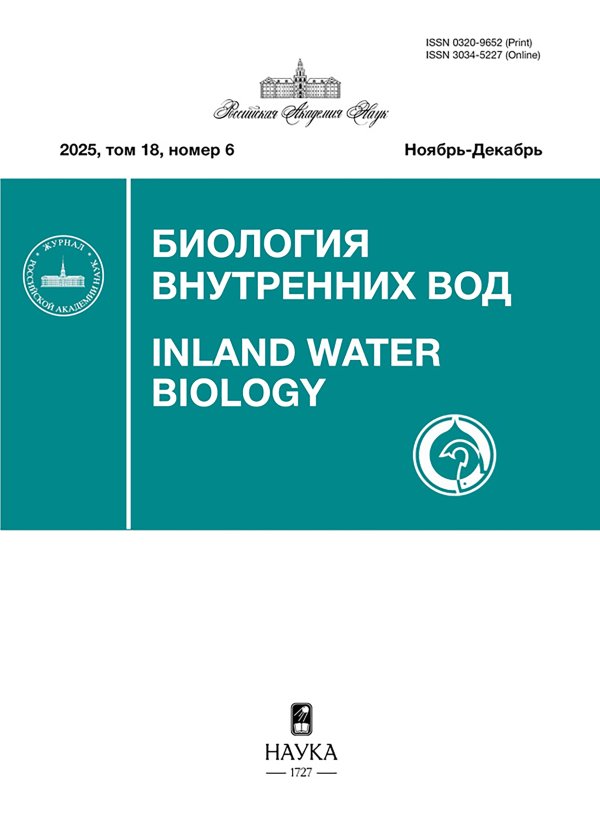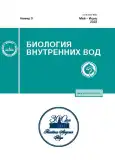Winter Dynamics of Drifting Invertebrates’ Vertical Distribution in a Small Salmon River
- Authors: Astakhov M.V.1
-
Affiliations:
- Federal Scientific Center of the East Asia Terrestrial Biodiversity, Far Eastern Branch, Russian Academy of Sciences
- Issue: No 3 (2023)
- Pages: 349-362
- Section: ЗООПЛАНКТОН, ЗООБЕНТОС, ЗООПЕРИФИТОН
- URL: https://journals.rcsi.science/0320-9652/article/view/134925
- DOI: https://doi.org/10.31857/S0320965223030038
- EDN: https://elibrary.ru/PGVOKS
- ID: 134925
Cite item
Full Text
Abstract
The composition of the winter syrton of a small salmon river was dominated by mayfly larvae (Ephemeroptera), dipteran larvae (Diptera), and adult water mites (Hydracarina). The presence of a significant linear dependence of the number of drifters entering the nets on the volume of water filtered by the nets has not been proven, so we used not the syrton density (ind./m3), but the data of actual catches. The vertical distribution of drifting invertebrates of different taxonomic affiliation had its own characteristics. Under conditions of good illumination of the water column, the drift intensity of invertebrates increased in the daytime. This fact is probably indirectly related to the low water temperature, which limits the swimming ability of drift-feeding fish, which because of this become more vulnerable to fish-feeding warm-blooded predators, and therefore in winter during daylight hours lead a predominantly inactive and secretive way of life. In December, most daytime drifters migrated near the surface of the water column, and in January, on the contrary, near the bottom. The latter may be due to the overwhelming effect of lower daytime air temperatures, since until mid-February the riverbed was not completely covered with ice. After a heavy February snowfall, the upper layers of the river flow turned out to be isolated from the effect of air temperature, and the level of illumination of the water column during the day began to correspond to the period of late twilight. As a result, fish became less accessible to warm-blooded semiaquatic predators, the intensity of invertebrate drift in the daylight hours decreased sharply, and the distribution of drifters throughout the water column vertical became fairly uniform.
About the authors
M. V. Astakhov
Federal Scientific Center of the East Asia Terrestrial Biodiversity, Far Eastern Branch, Russian Academy of Sciences
Author for correspondence.
Email: mvastakhov@mail.ru
Russia, Vladivostok
References
- Александров А.А., Трахтенгерц М.С. 1978. Вода. Плотность при атмосферном давлении и температурах от 0 до 100°С. Таблицы стандартных справочных данных ГСССД 2-77. М: Изд-во стандартов.
- Алексеевский Н.И. 2006. Гидрофизика. Москва: Академия.
- Астахов М.В. 2009. Дрифт фито- и зообентоса в модельной лососевой реке Кедровой (Приморский край, Россия). Дис. … канд. биол. наук. Владивосток.
- Богатов В.В. 1995. Комбинированная концепция функционирования речных экосистем // Вест. ДВО РАН. № 3. С. 51.
- Богатов В.В., Астахов М.В. 2013. Вертикальное распределение дрейфующих личинок поденок и двукрылых на перекате р. Кедровая (Приморский край) // Вест. СВНЦ ДВО РАН. № 1. С. 39.
- Васильев Н.Г., Панкратьев А.Г., Панов Е.Н. 1965. Заповедник “Кедровая падь”. Владивосток: Дальневост. книж. изд-во.
- Есин Е.В., Чебанова В.В., Леман В.Н. 2009. Экосистема малой лососевой реки Западной Камчатки (среда обитания, донное население и ихтиофауна). М: КМК.
- Живоглядов А.А. 2004. Структура и механизмы функционирования сообществ рыб малых нерестовых рек острова Сахалин. М: ВНИРО.
- Ключарева О.А. 1963. О скате и суточных вертикальных миграциях донных беспозвоночных Амура // Зоол. журн. Т. 42. Вып. 11. С. 1601.
- Константинов А.С. 1969. Сиртон и бентосток Волги близ Саратова в 1966 году // Зоол. журн. Т. 48. Вып. 1. С. 20.
- Леванидова И.М., Леванидов В.Я. 1965. Суточные миграции донных личинок насекомых в речной струе. 1. Миграция личинок поденок в реке Хор // Зоол. журн. Т. 44. Вып. 3. С. 373.
- Леванидов В.Я., Леванидова И.М. 1979. Дрифт водных насекомых в реке Амур // Систематика и экология рыб континентальных водоемов Дальнего Востока. Владивосток: ДВНЦ АН СССР. С. 3.
- Павлов К.Ф., Романков П.Г., Носков А.А. 1987. Примеры и задачи по курсу процессов и аппаратов химической технологии. Ленинград: Химия.
- Павлов Д.С., Скоробогатов М.А. 2014. Миграции рыб в зарегулированных реках. М: КМК.
- Семенченко А.Ю. 1977. Зимовка рыб в водотоках заповедника “Кедровая падь” // Пресноводная фауна заповедника “Кедровая падь”. Владивосток: ДВНЦ АН СССР. С. 159.
- Тарадина Д.Г., Павлов Д.С., Лупандин А.И. 1997. Связь вертикального распределения молоди рыб при покатной миграции с их плавучестью и турбулентностью потока // Вопр. ихтиологии. 1997. Т. 37. № 4. С. 532.
- Тарасов А.Г., Тарасова Г.В. 1997. Бентосток нижней части среднего течения р. Урал // Биология внутр. вод. № 1. С. 59.
- Травина Т.Н. 2014. Дрифт донных беспозвоночных в период ледостава в р. Большая (Западная Камчатка) // Чтения памяти В.Я. Леванидова. Вып. 6. С. 713.
- Чебанова В.В. 2009. Бентос лососевых рек Камчатки. Москва: ВНИРО.
- Шубина В.Н. 2006. Бентос лососевых рек Урала и Тимана. СПб: Наука.
- Allan J.D., Feifarek B.P. 1989. Distances travelled by drifting mayfly nymphs: factors influencing return to the substrate // J. North Am. Benthol. Soc. V. 8. № 4. P. 322. https://doi.org/10.2307/1467495
- Astakhov M.V. 2012. Stratifying drift sampler // Amur. Zool. J. V. 4. № 1. P. 3. https://www.biotaxa.org/azj/issue/view/9865/918
- Astakhov M.V., Bogatov V.V. 2014. Vertical redistribution of drifting benthic invertebrates in the Kedrovaya River, Primorsky Region of Russia // Open J. Ecol. V. 4. № 2. P. 53. https://doi.org/10.4236/oje.2014.42007
- Berner L.M. 1951. Limnology of the Lower Missouri River // Ecology. V. 32. № 1. P. 1. https://doi.org/10.2307/1930968
- Bogatov V.V., Astakhov M.V. 2011. Under-ice drift of invertebrates in the piedmont part of Kedrovaya River (Primorskii Krai) // Inland Water Biol. V. 4. № 1. P. 56. https://doi.org/10.1134/S1995082911010032
- Gorovaya E.A. 2022. Dynamics of the mayfly community structure (Insecta, Ephemeroptera) of a small salmon river in South Primorye // Inland Water Biol. V. 15. № 6. P. 891. https://doi.org/10.1134/S1995082922060062
- Campbell R.N.B. 1985. Comparison of the drift of live and dead Baetis nymphs in a weakening water current // Hydrobiologia. V. 126. P. 229. https://doi.org/10.1007/BF00007500
- Clifford H.F. 1972. A years’ study of the drifting organisms in a brown-water stream of Alberta, Canada // Can. J. Zool. V. 50. № 7. P. 975. https://doi.org/10.1139/z72-130
- Copp G.H., Faulkner H., Doherty S. et al. 2002. Diel drift behaviour of fish eggs and larvae, in particular barbel, Barbus barbus (L.), in an English chalk stream // Fish. Manag. Ecol. V. 9. Iss. 2. P. 95. https://doi.org/10.1046/j.1365-2400.2002.00286.x
- Crisp D.T., Gledhill T. 1970. A quantitative description of the recovery of the bottom fauna in a muddy reach of a mill stream in southern England after draining and dredging // Arch. Hydrobiol. Bd 67. H. 4. S. 502.
- D’Amours J., Thibodeau S., Fortin R. 2001. Comparison of lake sturgeon (Acipenser fulvescens), Stizostedion spp., Catostomus spp., Moxostoma spp., quillback (Carpiodes cyprinus), and mooneye (Hiodon tergisus) larval drift in Des Prairies River, Quebec // Can. J. Zool. V. 79. № 8. P. 1472. https://doi.org/10.1139/z01-095
- Douglas P.L., Forrester G.E., Cooper S.D. 1994. Effects of trout on the diel periodicity of drifting in baetid mayflies // Oecologia. V. 98. P. 48. https://doi.org/10.1007/BF00326089
- Downes B.J. 2010. Back to the future: little-used tools and principles of scientific inference can help disentangle effects of multiple stressors on freshwater ecosystems // Freshwater Biol. V. 55. P. 60. https://doi.org/10.1111/j.1365-2427.2009.02377.x
- Downes B.J., Lancaster J. 2010. Does dispersal control population densities in advection-dominated systems? A fresh look at critical assumptions and a direct test // J. Anim. Ecol. V. 79. Iss. 1. P. 235. https://doi.org/10.1111/j.1365-2656.2009.01620.x
- Elliott J.M. 1971. The distances travelled by drifting invertebrates in a Lake District stream // Oecologia. V. 6. P. 350. https://doi.org/10.1007/BF00389109
- Fenoglio S., Bo T., Gallina G., Cucco M. 2004. Vertical distrubution in the water column of drifting stream macroinvertebrates // J. Freshwater Ecol. V. 19. № 3. P. 485. https://doi.org/10.1080/02705060.2004.9664923
- Flecker A.S. 1992. Fish predation and the evolution of invertebrate drift periodicity: evidence from neotropical streams // Ecology. V. 73. Iss. 2. P. 438. https://doi.org/10.2307/1940751
- Fraser N.H.C., Metcalfe N.B., Thorpe J.E. 1993. Temperature-dependent switch between diurnal and nocturnal foraging in salmon // Proc. R. Soc. B. Biol. Sci. V. 252. P. 135. https://doi.org/10.1098/rspb.1993.0057
- Gisbert E., Williot P. 1997. Larval behavior and effect of the timing of initial feeding on growth and survival of siberian sturgeon (Acipenser baeri) larvae under small scale hatchery production // Aquaculture. V. 156. Iss. 1–2. P. 63. https://doi.org/10.1016/S0044-8486(97)00086-0
- Heggenes J., Alfredsen K., Bustos A.A. et al. 2018. Be cool: A review of hydro-physical changes and fish responses in winter in hydropower-regulated northern streams // Environ. Biol. Fish. V. 101. P. 1. https://doi.org/10.1007/s10641-017-0677-z
- Koporikov A.R., Bogdanov V.D. 2019. Burbot (Lota lota L., 1758) larval distribution in the streamflow during long downstream migration // Russ. J. Ecol. V. 50. № 5. P. 482. https://doi.org/10.1134/S1067413619050060
- Madsen B.L. 1969. Reactions of Brachyptera risi (Morton) (Plecoptera) nymphs to water current // Oikos. V. 20. № 1. P. 95. https://doi.org/10.2307/3543748
- Malmqvist B. 1988. Downstream drift in madeiran levadas: tests of hypotheses relating to the influence of predators on the drift of insects // Aquat. Insects. V. 10. Iss. 3. P. 141. https://doi.org/10.1080/01650428809361323
- Matter W.J., Hopwood A.J. 1980. Vertical distribution of invertebrate drift in a large river // Limnol., Oceanogr. V. 25. № 6. P. 1117. https://doi.org/10.4319/LO.1980.25.6.1117
- McLay C.L. 1968. A study of drift in the Kakanui River, New Zealand // Aust. J. Mar. Freshwater Res. V. 19. № 2. P. 139. https://doi.org/10.1071/MF9680139
- McLay C.L. 1970. A theory concerning the distance travelled by animals entering the drift of a stream // J. Fish Res. Board Can. V. 27. № 2. P. 359. https://doi.org/10.1139/f70-041
- McNair J.N., Newbold J.D., Hart D.D. 1997. Turbulent transport of suspended particles and dispersing benthic organisms: how long to hit bottom? // J. Theor. Biol. V. 188. Iss. 1. P. 29. https://doi.org/10.1006/jtbi.1997.0453
- Müller-Haeckel A., Marvanová L. 1979. Periodicity of aquatic hyphomycetes in the subarctic // Trans. Brit. Mycol. Soc. V. 73. Iss. 1. P. 109. https://doi.org/10.1016/S0007-1536(79)80080-7
- Naman S.M., Rosenfeld J.S., Richardson J.S. 2016. Causes and consequences of invertebrate drift in running waters: from individuals to populations and trophic fluxes // Can. J. Fish Aquat. Sci. V. 73. P. 1292. https://doi.org/10.1139/cjfas-2015-0363
- Oldmeadow D.F., Lancaster J., Rice S.P. 2010. Drift and settlement of stream insects in a complex hydraulic environment // Freshwater Biol. V. 55. Iss. 5. P. 1020. https://doi.org/10.1111/j.1365-2427.2009.02338.x
- Statzner B., Gore J.A., Resh V.H. 1988. Hydraulic stream ecology: observed patterns and potential applications // J. North Am. Benthol. Soc. V. 7. № 4. P. 307. https://doi.org/10.2307/1467296
- Townsend C.R. 1989. The patch dynamics concept of stream community ecology // J. North Am. Benthol. Soc. V. 8. № 1. P. 36. https://doi.org/10.2307/1467400
- Valdimarsson S.K., Metcalfe N.B. 1998. Shelter selection in juvenile Atlantic salmon, or why do salmon seek shelter in winter? // J. Fish Biol. V. 52. Iss. 1. P. 42. https://doi.org/10.1111/j.1095-8649.1998.tb01551.x
- Vannote R.L., Minshall G.W., Cummins K.W. et al. 1980. The river continuum concept // Can. J. Fish Aquat. Sci. V. 37. № 1. P. 130. https://doi.org/10.1139/f80-017
- Weissenberger J., Spatz H.-Ch., Emanns A., Schwoerbel J. 1991. Measurement of lift and drag forces in the mN range experienced by benthic arthropods at flow velocities below 1.2 m s‒1 // Freshwater Biol. V. 25. Iss. 1. P. 21. https://doi.org/10.1111/j.1365-2427.1991.tb00469.x












